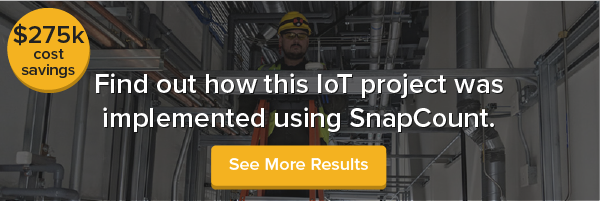
The global market for lighting retrofits is growing at a staggering annual rate of over 9%. Analysts predict it will reach a value close to $5 billion by 2026.
It’s easy to understand why. LED technology is only getting more efficient and longer lasting. Companies, hospitals, schools, and other large organizations see lighting as a key to a complete energy transformation that will save electricity and money sooner, rather than later.
In this fast-growing industry, there are many opportunities for lighting retrofitters. But scaling your business to meet the demand can be a daunting task. Fittingly for this industry, growing your business comes down to efficiency: finding ways to do more, faster, with fewer staff.
Technology-driven solutions are available to help you maximize the potential of your retrofitting business. But first, you must get your house in order. I’m often reminded of this quote by Bill Gates:
“The first rule of any technology used in a business is that automation applied to an efficient operation will magnify the efficiency. The second is that automation applied to an inefficient operation will magnify the inefficiency.”
The good news is, when your operations are running at optimal efficiency, your business will be able to take on bigger projects and better clients – enabling you to build the business you truly want.
How do you prime your lighting retrofit business for growth? Here are a few tips we’ve curated from some of our most successful clients and colleagues. (Have suggestions of your own? We’d love to hear them!)
1. Boost the Quality of Your Audits
Reg Cook, the CEO of Hemma Lighting Solutions, points out that performing audits (or “surveys,” if you prefer) does not, in itself, generate revenue. The revenue comes from doing the work, a good audit helps you win and best service the client.
But that doesn’t mean you should skimp on the audit. In fact, Cook says, retrofitting companies should have the financial strength to self-fund audits.
“The key to a good project is the greatest survey possible,” Cook tells us. “You have to spend the time up front to make your project go smoothly down the road.”
Although an audit can be a sales tool to help you win jobs, but more specifically, an audit is a roadmap to a successful lighting retrofit.
“I still use the same two or three surveyors I’ve used for the past 25 years. They count everything,” Cook says. “They don’t look in a room and count 20 fixtures when there’s only 17. So, I get the best survey from them, and the best survey drives an easy install.”
The more details in your audits, the easier it will be to hit the ground running when the work begins. We wrote recently about how collecting attributes such as lens size and style, voltage information, controls information, and fixture height can improve project management. But gathering all this data by hand and transferring it to spreadsheets can be time-consuming and prone to error.
Lighting retrofit software such as SnapCount will help your auditors generate detail-rich surveys without sacrificing efficiency.
2. Streamline Product Ordering and Inventory Management
Tim Donovan, CEO of Donovan Energy, remembers a time when ordering material could bring a retrofitting project to a standstill.
When audits were completed with pen, paper, and spreadsheets, it would take a day or more just to determine what parts you needed. Then, you would have to talk to different manufacturers and vendors to find out what they had in inventory. Just getting pricing information can take two to three weeks!
And that’s not to mention transposition errors, which, Donovan says, “can kill you in this business.”
“If I’m paying an electrical contractor to be on site, and they get there, and the wrong product shows up because we typed in an ‘eight’ instead of a ‘seven,’ that costs me real money,” Donovan says. “The job profitability starts to go down right away because the contractor doesn’t have the material. Either they’re inefficient, or worse, they leave. Then, I have to pay another mobilization fee to get them back out there to finish the job, and I have restocking fees I can’t pass onto my customer.”
Donovan has seen a world of difference since his firm started using lighting retrofit software for product ordering and inventory management. The right software can give you visibility into pricing and availability from an array of vendors, allowing you to manage orders and track shipments with the same tool you use to perform audits and manage projects.
The result is a product ordering process that is streamlined and optimized. The ability to see product needs across multiple projects gives you leverage to negotiate better prices from manufacturers. Visibility into inventory and shipping times enables you to plan ahead and manage client expectations.
Donovan says his team is now able to spread orders out across different vendors to find the lowest prices.
“Before, you weren’t going to sit there and key in six different purchase orders, even though, in theory, you could optimize those 20 SKUs to get the lowest price from six different vendors,” he says. “Well now, it’s a piece of cake.”
3. Improve Accountability With Your Install Crew
When you work with outsourced installation teams (which many lighting retrofitters do), you need to be aware that, although they don’t work for your company directly, your contractors represent you to your clients. Clients expect professionalism, in how your team presents themselves and behaves onsite, as well as how efficiently they finish the work.
The success of a retrofitting project rests in your ability to make sure your crew is staying within scope, on schedule, and on budget. But when you have teams in different states, or at multiple sites throughout the country, it can be challenging to monitor them.
Reg Cook’s motto is “trust but verify.”
The trust side of the equation comes from hiring people you can count on and training them properly. The verify side comes from constant communication, receiving daily updates from all your worksites and visiting in-person when you can.
Cook says that many of his installation teams work third-shift, but his operations team works during the day. Their lighting retrofit software, SnapCount, helps them stay in sync. Each night, the crews update SnapCount with room-by-room descriptions of the work they completed. The information is waiting for operations personnel as soon as they come to work the next morning.
4. Surround Yourself With the Right People
Leading companies in almost any business field can often trace their success to assembling the right team from the get-go.
When Reg Cook launched Hemma Lighting Solutions, he told us, he didn’t have many contacts with experience in the lighting industry (not many did at the time), but he did have a strong network of colleagues, friends, and family in the construction business.
“Lighting is just a very focused construction project,” Cook says. “So, I hired people that had skills in project management, which remains the most critical aspect of what we do.”
On the installation side of things, Cook’s firm searches for reliable workers and brings them up to speed under the watchful eyes of experienced experts.
“We work with a local construction agency that focuses on finding qualified people in our field, and we bring them on using a temp-to-perm model,” Cook explains. “We put new hires on a crew under a highly-experienced team lead who can usually tell right away, ‘This person is going to work,’ or ‘This person will need a more hands-on approach.’”
As Cook puts it, “You have to kiss a lot of frogs, sometimes, to find the right people.”
5. Carefully Plan Multi-Site Installations
There can be a bit of a learning curve with any new project as your team adapts to the layout of a building and the work that goes on there. When you’re dealing with multiple sites, it’s best to plan ahead and start slow, Cook says.
“We always start slow to learn the different nuances of a facility and then ramp up as the project continues,” he says.
Now It’s Your Turn
The lighting retrofit industry is still relatively new to the world, and no one can claim to have completely figured it out yet. We’re eager to hear from you about your ideas, best practices, and lessons learned from scaling your retrofit business. We’ll add the best ones to this article – providing, of course, full credit to your company and link to your website.
Share away!






Share this post: